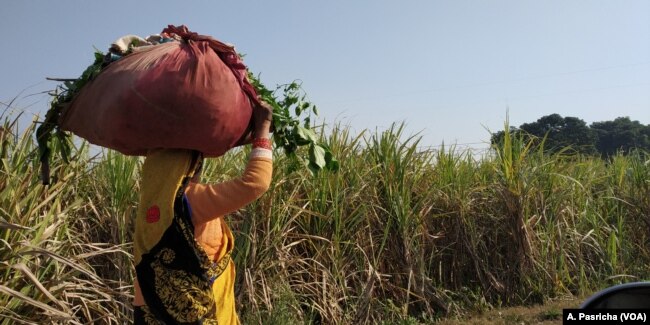As Sitabh Malik prepares to harvest his winter crop and plant wheat, he is apprehensive. The 36-year-old spends much of the day patrolling his farm in Abupur village in Uttar Pradesh state to chase stray cows that intrude into his fields and eat his crops, VOA news reports.
“Whatever crop I planted, such as rice, they did not leave anything,” rues Malik as he walks around his fields on a chilly winter morning. “Then I planted mustard, hoping they won’t eat it, but they ate that up also. Now they are destroying the fodder I have grown.” Even as he speaks, he spots two calves that have wandered in and rushes to chase them out.
Malik’s problems intensified after the state’s Hindu nationalist government, elected nearly two years ago, imposed tough restrictions on the cattle trade to protect cows that Hindus consider holy. Stricter implementation of laws that include prison terms and a crackdown on what the government says were illegal slaughter houses have virtually shut down a thriving trade in aged animals that were previously sold for meat or hides.
5 million stray cattle
The result: Farmers quietly abandon their aged animals under the cover of darkness in neighboring villages or roads resulting in a massive spike in the number of stray cows. By one estimate more than 5 million stray cattle roam the countryside in India. The problem is more intense in states in the north of the country where the Hindu nationalist governments that rule several states have made protection of cows a top agenda.
In states such as Uttar Pradesh that ban cow slaughter, the animals usually had been transported to states where laws were less restrictive. But that movement has virtually stopped as bands of aggressive cow vigilantes patrol highways and stop trucks they suspect of transporting cows. The vigilantes have been blamed for several violent attacks.
Villagers say the stray cows have emerged as a greater threat to their crops than weather uncertainties. Economists warn that the cows pose the latest challenge to a rural economy already reeling under the pressure of low crop prices.
Farmers devastated
Just a few kilometers from Abupur, another village, Didoli is also coping with the havoc caused by stray cows.
“In the last six months, this problem has intensified by 90 percent. It has increased because everybody is letting loose their animals,” according to Ram Kumar Tyagi. “Farmers have been devastated,” says the aged farmer and points out that the chill of winter nights makes it difficult to patrol the fields after darkness, when cows emerge in large numbers.
These villages are among thousands across the state where farmers are complaining of heavy losses. As anger runs high, in some places farmers have locked up stray cows in village schools to protect their fields.
Some are stringing barbed wire to save their crops, but most farmers who have small patches of land cannot afford sturdy enough fences. Others try low cost solutions: They are tying strips of silver ribbon on the field’s periphery, whose glare they say, distracts the cows.
Arun Kumar in Didoli village is a relatively well-off farmer. His 16 cows include male calves and some aged ones that have stopped giving milk. He continues to take care of these animals, but says smaller farmers cannot afford to feed unproductive animals because it adds to the burden of poor rural households.
“We have told officials, leaders, whoever we meet that this is the biggest problem we face today,” he says. But no answers have been forthcoming. “They say, ‘We will think about it,’ but so far there is no solution.”
No easy fix
There are no quick fixes. Although Hindu charities and the government run shelters for aged cows across the country, they are too few in number to accommodate the millions of stray cows. The closest shelter to Abupur and Didoli village lies in Ghaziabad town, but it is overcrowded with 1,250 cows. Supervisor Ashok Pandey has to turn down frequent requests to house more animals.
“We are already short of space. We have taken in as many as possible,” Pandey said.
The threats from stray cattle have led the Uttar Pradesh government to impose a special “cow welfare” tax this month that it says will be used to build more shelters.
But economists say that it is still financially unviable for one of the country’s poorest states to fund enough shelters to house the strays.
“I know every government has the right to follow policies on the basis of faith and belief for social reasons, but the government should be aware of the cost implications,” says Amitabh Kundu at the Research and Information System for Developing Countries, a think tank in New Delhi. “You cannot put the burden on the farmers. You can’t take the burden on yourself because then your allocation for other social sectors will come down so I find absolutely no rationality in moving in that direction.”
The government has vowed not to compromise on its goal of protecting cows. But with general elections just months away and anger growing in the countryside, analysts say it must also move quickly to assure rural communities that their labor and livelihoods too will be protected.

